This species was first observed, during the summer of 1829, when an individual female flew into the apartment of the late Dr. Hammersly, then one of the resident physicians of the Pennsylvania hospital: on the subsequent evening a male individual, of the same species, was also taken in the same manner. In August 1830, a very fine specimen was brought to the Academy of Natural Sciences, and Mr. Audubon informs me that the species has very recently been observed in New York.
The natural characters of the species are—General colour black, sprinkled with gray above and beneath; ears black and naked; auriculum, short and broad or obtusely triangular; interfemoral membrane, sparsely hairy; last joint of the tail free: two incisors, with notched crowns, on each side of the canine teeth of the upper jaw, with a broad intervening space without teeth.
The dimensions are.—Total length 3 inches 7 tenths; tail 1.7; length of ear 0.5. breadth of ear 0.4; length of leg 1.7; spread of wings 10.7. inhabit Pennsylvania and New York, and probably the southern states.—Cab. of Acad. Nat. Sc. Philad. (Abridged from Featherstonhaugh’s Monthly American Journal of Geology and Natural Science.)
* * * * *
FINE ARTS.
* * * * *
MOSAIC PAVEMENT.
The chief object of curiosity at Palestrina, (ancient Praeneste,) is the castle or palace of the prince, in the highest part of the city, to which there is an ascent by an excellent coach-road to the right, by the Capucin Convent, without entering the narrow street. Before it is a level space of considerable length; which formed the highest platform of the Temple of Fortune. Two flights of steps lead to an amphitheatre, or semicular staircase, in excellent preservation, which is the same that led to the sanctuary of the temple, on the foundation of which the palace is built: in the middle of the semicircle is a well; each step is about a foot and a half high, like the ancient steps of the capitol which led to the church of Ara Coeli, at Rome. Another short flight conducts to the hall of entrance, where there is a double staircase, and a recess closed by iron grates, which contains the celebrated antique pavement, of which Pliny speaks in the following terms, “The fine mosaic of small stones, placed by Sylla as a pavement in the Temple of Fortune at Praeneste, was the first thing of the kind seen in Italy.” There does not seem to be the smallest room to doubt of this being the genuine mosaic he mentions; it is in excellent preservation, and appears to be about twenty feet by sixteen. It was found in the same cellar of the seminary, where is still the altar of Fortune, and may be considered as one of the most interesting relics of antiquity. Towards the upper part of it are mountains, with negro savages hunting wild beasts;




